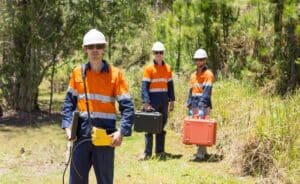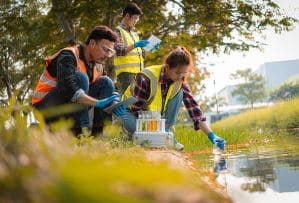Geotechnical site investigations are a critical part of ensuring a successful construction project. These investigations help developers understand the physical properties of the ground beneath a proposed site, providing data on soil layers, soil condition, and rock formations. This data informs key decisions, such as foundation design and site suitability, helping to avoid costly project delays, safety issues, and compliance problems.
In Australia, where various environmental factors and complex geologies often come into play, comprehensive geotechnical investigations are essential to the development process. These investigations play a central role in protecting the environment and ensuring that projects comply with state and federal environmental regulations.
Importance of Geotechnical Site Investigations
Geotechnical site investigations are crucial for understanding the physical properties of a site’s subsurface materials, such as soil and rock. These investigations are used to evaluate how the ground will behave under the pressures of construction and help mitigate risks associated with site instability. The data gathered from these investigations can prevent a range of potential issues, including structural failures, environmental damage, and costly construction delays.
One of the primary reasons for conducting a geotechnical site investigation is to assess the soil condition at various depths. Soil exploration techniques, such as boring and trenching, help gather information about the composition and behavior of the soil. These findings are critical for making decisions about foundation types, drainage systems, and material selection. Furthermore, understanding the soil’s chemical composition can reveal potential risks, such as corrosion or contamination, which need to be addressed before construction can begin.
Without a comprehensive site investigation, developers may encounter unexpected soil layers or groundwater, which can lead to delays and additional costs. For example, discovering weak or contaminated soil during construction could require a complete redesign of the foundation or costly remediation efforts. A well-executed geotechnical investigation helps avoid these pitfalls by providing accurate, actionable data early in the planning process.
Key Components of Geotechnical Site Investigations
Geotechnical investigations are typically carried out in several stages, each contributing to a detailed understanding of the subsurface conditions:
1. Preliminary Site Investigation
The preliminary phase involves reviewing existing data, conducting site reconnaissance, and performing initial assessments to determine the general nature of the site. This stage provides an overview of the soil and rock composition, topography, and potential hazards that may affect construction.
2. Field Exploration
Field exploration is the heart of the geotechnical investigation process. This stage involves collecting soil samples through test borings, drilling, and trenching. These samples are later analyzed in the laboratory to determine their physical and chemical properties. The data gathered during field exploration is crucial for identifying the bearing capacity of the soil, groundwater conditions, and the suitability of the site for construction.
3. Supplementary Investigation
In cases where initial findings reveal unusual or complex subsurface conditions, a supplementary investigation may be necessary. This involves additional tests or borings to gather more precise data, especially regarding groundwater behavior or the chemical composition of the soil. Supplementary investigations ensure that all potential risks are identified and mitigated before construction begins.
Each of these stages of site investigation is essential for gathering comprehensive data and minimizing risks associated with soil and rock conditions.
Geotechnical Testing Methods
Once the field exploration phase is completed, various geotechnical testing methods are employed to analyze the soil and rock samples. These methods provide critical information about the soil’s strength, stability, and suitability for construction. Below are some common geotechnical testing methods:
Standard Penetration Test (SPT)
The SPT is a widely used test in geotechnical engineering. It involves driving a sampler into the ground at various depths to measure the resistance of the soil. This test helps determine the density and consistency of the soil, which are important factors when designing foundations for buildings or other structures. The data from SPTs is used to classify soil layers and assess their ability to support loads.
Cone Penetration Test (CPT)
The CPT is a more advanced method that involves pushing a cone-shaped probe into the ground to measure soil resistance. This test provides continuous data on soil composition and strength without the need for drilling. CPT is particularly useful for assessing the mechanical properties of soil and rock layers, helping engineers make informed decisions about foundation design and site stability.
Laboratory Tests
After collecting soil samples from the field, they are analyzed in the laboratory to determine their physical and chemical properties. These tests include grain size distribution, moisture content, shear strength, and permeability. Laboratory tests also examine the chemical composition of the soil, identifying any contaminants or corrosive elements that may affect the construction materials or the environment. The results of these tests are vital for determining the structural integrity of the proposed project and ensuring compliance with environmental regulations.
Test Borings
Test borings are drilled into the ground to extract cylindrical samples of soil and rock. These samples provide detailed information about the stratification of soil layers and the presence of groundwater. Test borings are an essential part of the field exploration process, offering a direct view of the subsurface conditions.
The combination of these testing methods allows for a comprehensive understanding of the soil condition, ensuring that the construction project can proceed safely and efficiently.
Data Analysis and Interpretation
Once the geotechnical testing phase is complete, the collected data must be analyzed and interpreted. This involves evaluating the physical and chemical properties of the soil layers and identifying any potential risks. Engineers use this data to create detailed ground models, which serve as the foundation for designing safe and stable structures.

- Soil density and compaction: This helps determine the load-bearing capacity of the soil.
- Water content and permeability: These factors influence drainage design and the risk of water-related damage.
- Chemical composition: This is crucial for identifying contaminants that could affect construction materials or the environment.
The data analysis phase is critical for ensuring that the proposed construction project will be structurally sound and environmentally safe. Without thorough interpretation, there’s a risk of overlooking important variables that could lead to project delays or failures.
Geotechnical Reports and Recommendations
After analyzing the data, geotechnical engineers compile their findings into a comprehensive report. This report provides detailed insights into the soil condition, potential risks, and recommended solutions. The report typically includes the following sections:
- Site description: A detailed overview of the site, including topography, soil layers, and any environmental factors.
- Test results: A summary of the laboratory tests, field explorations, and geotechnical testing methods used during the investigation.
- Risk assessment: An evaluation of potential risks associated with the soil condition, such as slope instability, soil contamination, or groundwater issues.
- Recommendations: Practical solutions for foundation design, drainage, and other construction-related concerns based on the site’s subsurface conditions.
The geotechnical report is an essential tool for developers and project managers, offering actionable insights to guide decision-making and ensure project success. By addressing potential risks early in the process, the report helps prevent costly delays and ensures compliance with environmental regulations.
Common Geotechnical Challenges and Solutions
During geotechnical site investigations, several common challenges may arise. Addressing these challenges early on is crucial for keeping the project on track and within budget. Below are some of the most frequent issues and their solutions:
Unstable Soil
Unstable soil can cause significant problems for construction projects, as it may not be able to support the weight of the structure. In these cases, geotechnical engineers may recommend soil stabilization techniques, such as soil mixing or the use of geosynthetics, to improve the soil’s load-bearing capacity.
Contaminated Soil
Soil contamination is another common issue, particularly in industrial or urban areas. If contaminants are detected in the soil, remediation efforts, such as excavation and disposal or on-site treatment, must be undertaken before construction can proceed. Ensuring that the contaminated soil is safely managed is crucial for meeting environmental regulations and avoiding legal issues.
High Water Table
A high water table can cause flooding or foundation instability if not properly managed. To address this, geotechnical engineers may recommend installing drainage systems or using waterproof materials to protect the structure. Proper groundwater management is essential for maintaining the long-term stability of the building.
Why Geotechnical Investigations Are Key to Your Project’s Success
Geotechnical site investigations are a cornerstone of successful construction projects. They provide vital information about soil and rock conditions, helping to prevent structural failures, environmental harm, and costly delays. At iEnvironmental Australia, we specialize in delivering thorough and reliable geotechnical investigations that help you navigate the complexities of construction in Australia.
Whether you’re planning a large-scale development or a smaller project, our team of experts can tailor a geotechnical investigation to meet your specific needs. Reach out to us today to learn more about how we can help you ensure compliance, mitigate risks, and achieve project success.


